Individual Design Thinking Reflection Report - JCU Project
VerifiedAdded on 2023/06/03
|8
|1655
|409
Report
AI Summary
This report presents a student's reflection on a design thinking sprint project, covering processes, prototyping, and teamwork. The reflection on design thinking processes discusses the five-day integrative process, emphasizing the importance of systematic problem-solving and idea generation. The author reflects on the fulfilling aspects of assessments and the challenges of misinterpreting business information. The prototype reflection covers the use of clickable prototypes, paper prototyping, and digital prototyping, highlighting their impact on planning and UX processes. The author also shares insights on future improvements in prototyping methodologies. The teamwork reflection emphasizes the collaborative nature of the design sprint, the value of team orientation, and the challenges of idea generation clashes. The author identifies personal strengths and weaknesses, such as communication skills and a lack of empathetic behavior, and suggests developing a more empathetic approach for future projects. The report concludes with references to support the reflections and insights.
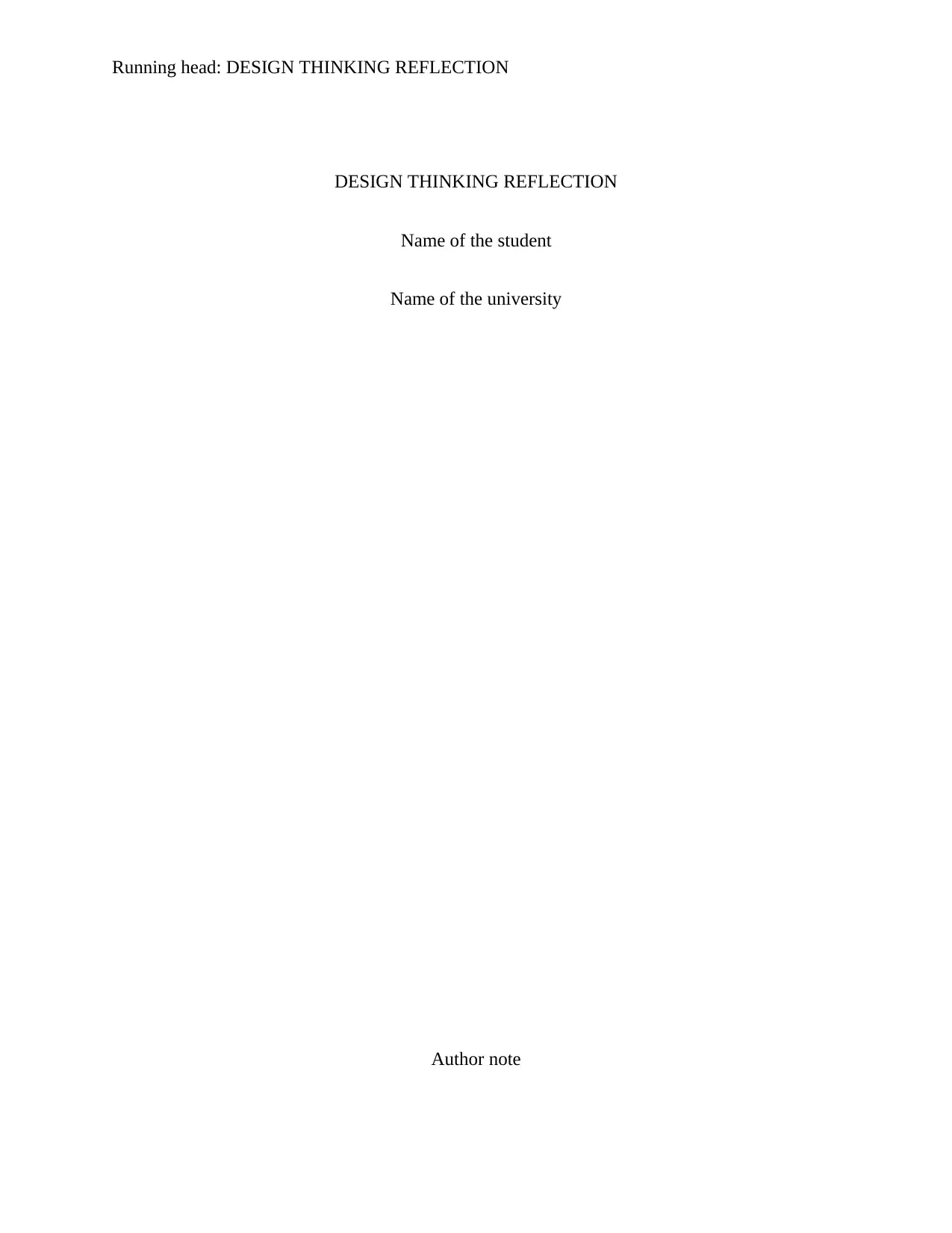
Running head: DESIGN THINKING REFLECTION
DESIGN THINKING REFLECTION
Name of the student
Name of the university
Author note
DESIGN THINKING REFLECTION
Name of the student
Name of the university
Author note
Paraphrase This Document
Need a fresh take? Get an instant paraphrase of this document with our AI Paraphraser
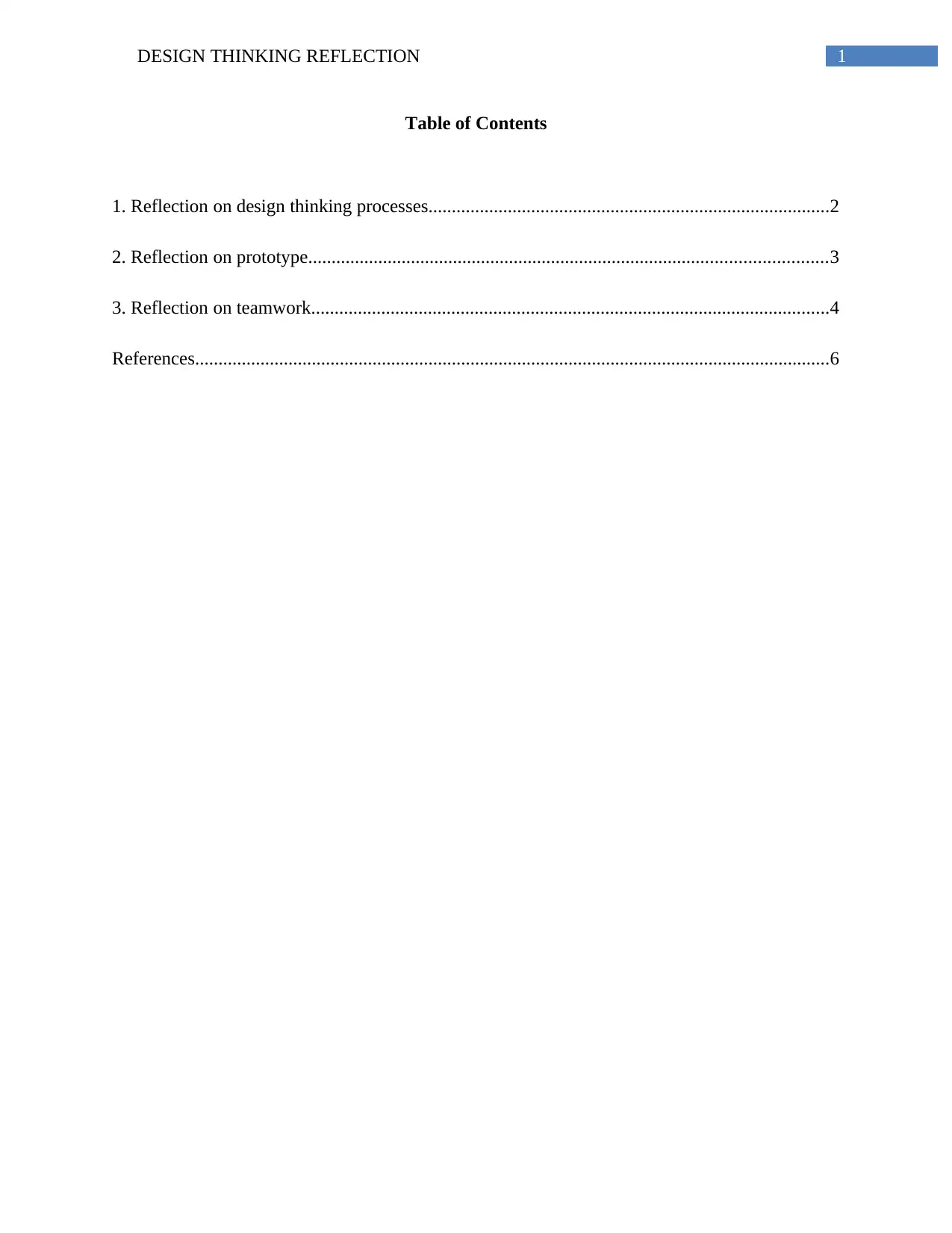
1DESIGN THINKING REFLECTION
Table of Contents
1. Reflection on design thinking processes......................................................................................2
2. Reflection on prototype...............................................................................................................3
3. Reflection on teamwork...............................................................................................................4
References........................................................................................................................................6
Table of Contents
1. Reflection on design thinking processes......................................................................................2
2. Reflection on prototype...............................................................................................................3
3. Reflection on teamwork...............................................................................................................4
References........................................................................................................................................6
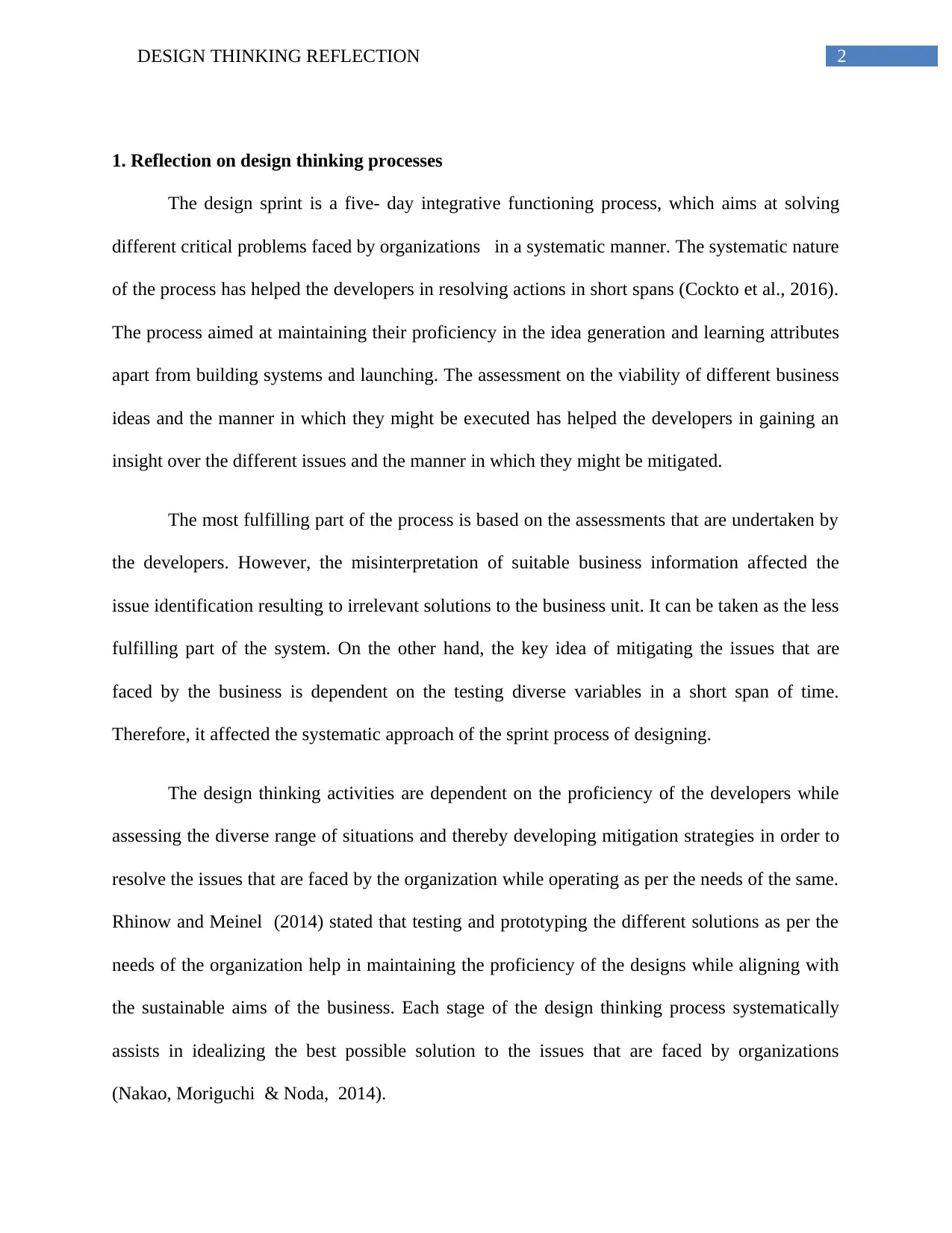
2DESIGN THINKING REFLECTION
1. Reflection on design thinking processes
The design sprint is a five- day integrative functioning process, which aims at solving
different critical problems faced by organizations in a systematic manner. The systematic nature
of the process has helped the developers in resolving actions in short spans (Cockto et al., 2016).
The process aimed at maintaining their proficiency in the idea generation and learning attributes
apart from building systems and launching. The assessment on the viability of different business
ideas and the manner in which they might be executed has helped the developers in gaining an
insight over the different issues and the manner in which they might be mitigated.
The most fulfilling part of the process is based on the assessments that are undertaken by
the developers. However, the misinterpretation of suitable business information affected the
issue identification resulting to irrelevant solutions to the business unit. It can be taken as the less
fulfilling part of the system. On the other hand, the key idea of mitigating the issues that are
faced by the business is dependent on the testing diverse variables in a short span of time.
Therefore, it affected the systematic approach of the sprint process of designing.
The design thinking activities are dependent on the proficiency of the developers while
assessing the diverse range of situations and thereby developing mitigation strategies in order to
resolve the issues that are faced by the organization while operating as per the needs of the same.
Rhinow and Meinel (2014) stated that testing and prototyping the different solutions as per the
needs of the organization help in maintaining the proficiency of the designs while aligning with
the sustainable aims of the business. Each stage of the design thinking process systematically
assists in idealizing the best possible solution to the issues that are faced by organizations
(Nakao, Moriguchi & Noda, 2014).
1. Reflection on design thinking processes
The design sprint is a five- day integrative functioning process, which aims at solving
different critical problems faced by organizations in a systematic manner. The systematic nature
of the process has helped the developers in resolving actions in short spans (Cockto et al., 2016).
The process aimed at maintaining their proficiency in the idea generation and learning attributes
apart from building systems and launching. The assessment on the viability of different business
ideas and the manner in which they might be executed has helped the developers in gaining an
insight over the different issues and the manner in which they might be mitigated.
The most fulfilling part of the process is based on the assessments that are undertaken by
the developers. However, the misinterpretation of suitable business information affected the
issue identification resulting to irrelevant solutions to the business unit. It can be taken as the less
fulfilling part of the system. On the other hand, the key idea of mitigating the issues that are
faced by the business is dependent on the testing diverse variables in a short span of time.
Therefore, it affected the systematic approach of the sprint process of designing.
The design thinking activities are dependent on the proficiency of the developers while
assessing the diverse range of situations and thereby developing mitigation strategies in order to
resolve the issues that are faced by the organization while operating as per the needs of the same.
Rhinow and Meinel (2014) stated that testing and prototyping the different solutions as per the
needs of the organization help in maintaining the proficiency of the designs while aligning with
the sustainable aims of the business. Each stage of the design thinking process systematically
assists in idealizing the best possible solution to the issues that are faced by organizations
(Nakao, Moriguchi & Noda, 2014).
⊘ This is a preview!⊘
Do you want full access?
Subscribe today to unlock all pages.

Trusted by 1+ million students worldwide
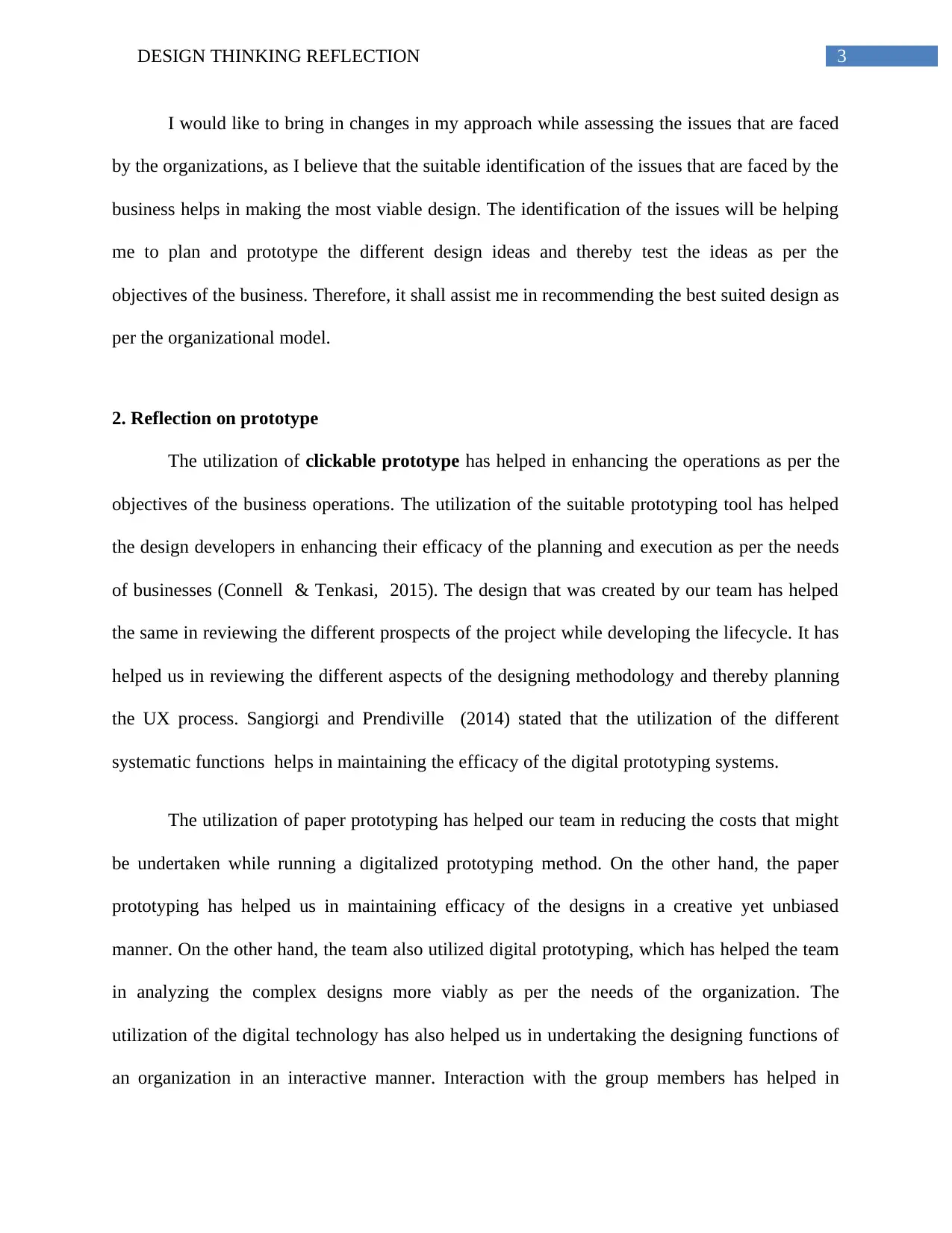
3DESIGN THINKING REFLECTION
I would like to bring in changes in my approach while assessing the issues that are faced
by the organizations, as I believe that the suitable identification of the issues that are faced by the
business helps in making the most viable design. The identification of the issues will be helping
me to plan and prototype the different design ideas and thereby test the ideas as per the
objectives of the business. Therefore, it shall assist me in recommending the best suited design as
per the organizational model.
2. Reflection on prototype
The utilization of clickable prototype has helped in enhancing the operations as per the
objectives of the business operations. The utilization of the suitable prototyping tool has helped
the design developers in enhancing their efficacy of the planning and execution as per the needs
of businesses (Connell & Tenkasi, 2015). The design that was created by our team has helped
the same in reviewing the different prospects of the project while developing the lifecycle. It has
helped us in reviewing the different aspects of the designing methodology and thereby planning
the UX process. Sangiorgi and Prendiville (2014) stated that the utilization of the different
systematic functions helps in maintaining the efficacy of the digital prototyping systems.
The utilization of paper prototyping has helped our team in reducing the costs that might
be undertaken while running a digitalized prototyping method. On the other hand, the paper
prototyping has helped us in maintaining efficacy of the designs in a creative yet unbiased
manner. On the other hand, the team also utilized digital prototyping, which has helped the team
in analyzing the complex designs more viably as per the needs of the organization. The
utilization of the digital technology has also helped us in undertaking the designing functions of
an organization in an interactive manner. Interaction with the group members has helped in
I would like to bring in changes in my approach while assessing the issues that are faced
by the organizations, as I believe that the suitable identification of the issues that are faced by the
business helps in making the most viable design. The identification of the issues will be helping
me to plan and prototype the different design ideas and thereby test the ideas as per the
objectives of the business. Therefore, it shall assist me in recommending the best suited design as
per the organizational model.
2. Reflection on prototype
The utilization of clickable prototype has helped in enhancing the operations as per the
objectives of the business operations. The utilization of the suitable prototyping tool has helped
the design developers in enhancing their efficacy of the planning and execution as per the needs
of businesses (Connell & Tenkasi, 2015). The design that was created by our team has helped
the same in reviewing the different prospects of the project while developing the lifecycle. It has
helped us in reviewing the different aspects of the designing methodology and thereby planning
the UX process. Sangiorgi and Prendiville (2014) stated that the utilization of the different
systematic functions helps in maintaining the efficacy of the digital prototyping systems.
The utilization of paper prototyping has helped our team in reducing the costs that might
be undertaken while running a digitalized prototyping method. On the other hand, the paper
prototyping has helped us in maintaining efficacy of the designs in a creative yet unbiased
manner. On the other hand, the team also utilized digital prototyping, which has helped the team
in analyzing the complex designs more viably as per the needs of the organization. The
utilization of the digital technology has also helped us in undertaking the designing functions of
an organization in an interactive manner. Interaction with the group members has helped in
Paraphrase This Document
Need a fresh take? Get an instant paraphrase of this document with our AI Paraphraser
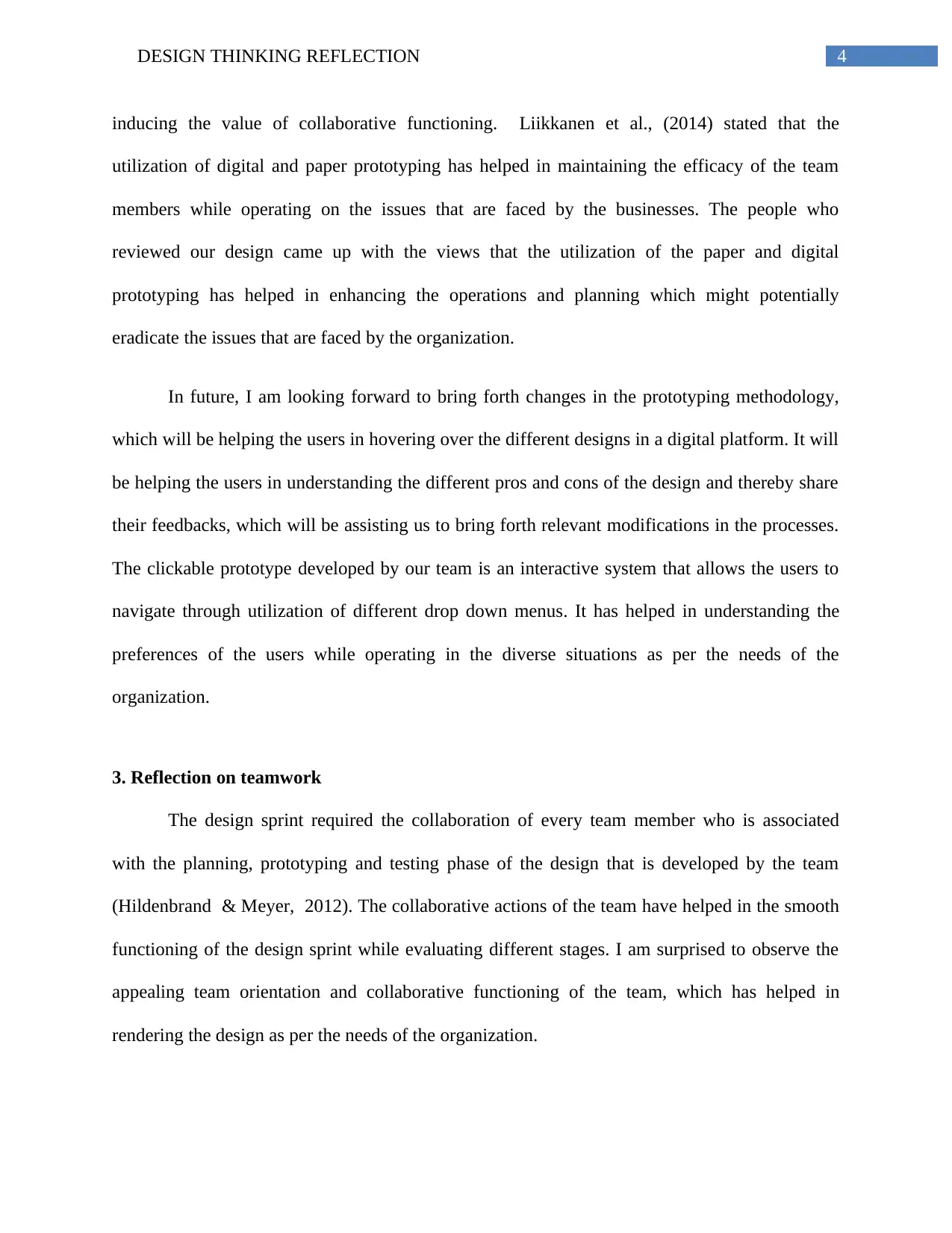
4DESIGN THINKING REFLECTION
inducing the value of collaborative functioning. Liikkanen et al., (2014) stated that the
utilization of digital and paper prototyping has helped in maintaining the efficacy of the team
members while operating on the issues that are faced by the businesses. The people who
reviewed our design came up with the views that the utilization of the paper and digital
prototyping has helped in enhancing the operations and planning which might potentially
eradicate the issues that are faced by the organization.
In future, I am looking forward to bring forth changes in the prototyping methodology,
which will be helping the users in hovering over the different designs in a digital platform. It will
be helping the users in understanding the different pros and cons of the design and thereby share
their feedbacks, which will be assisting us to bring forth relevant modifications in the processes.
The clickable prototype developed by our team is an interactive system that allows the users to
navigate through utilization of different drop down menus. It has helped in understanding the
preferences of the users while operating in the diverse situations as per the needs of the
organization.
3. Reflection on teamwork
The design sprint required the collaboration of every team member who is associated
with the planning, prototyping and testing phase of the design that is developed by the team
(Hildenbrand & Meyer, 2012). The collaborative actions of the team have helped in the smooth
functioning of the design sprint while evaluating different stages. I am surprised to observe the
appealing team orientation and collaborative functioning of the team, which has helped in
rendering the design as per the needs of the organization.
inducing the value of collaborative functioning. Liikkanen et al., (2014) stated that the
utilization of digital and paper prototyping has helped in maintaining the efficacy of the team
members while operating on the issues that are faced by the businesses. The people who
reviewed our design came up with the views that the utilization of the paper and digital
prototyping has helped in enhancing the operations and planning which might potentially
eradicate the issues that are faced by the organization.
In future, I am looking forward to bring forth changes in the prototyping methodology,
which will be helping the users in hovering over the different designs in a digital platform. It will
be helping the users in understanding the different pros and cons of the design and thereby share
their feedbacks, which will be assisting us to bring forth relevant modifications in the processes.
The clickable prototype developed by our team is an interactive system that allows the users to
navigate through utilization of different drop down menus. It has helped in understanding the
preferences of the users while operating in the diverse situations as per the needs of the
organization.
3. Reflection on teamwork
The design sprint required the collaboration of every team member who is associated
with the planning, prototyping and testing phase of the design that is developed by the team
(Hildenbrand & Meyer, 2012). The collaborative actions of the team have helped in the smooth
functioning of the design sprint while evaluating different stages. I am surprised to observe the
appealing team orientation and collaborative functioning of the team, which has helped in
rendering the design as per the needs of the organization.
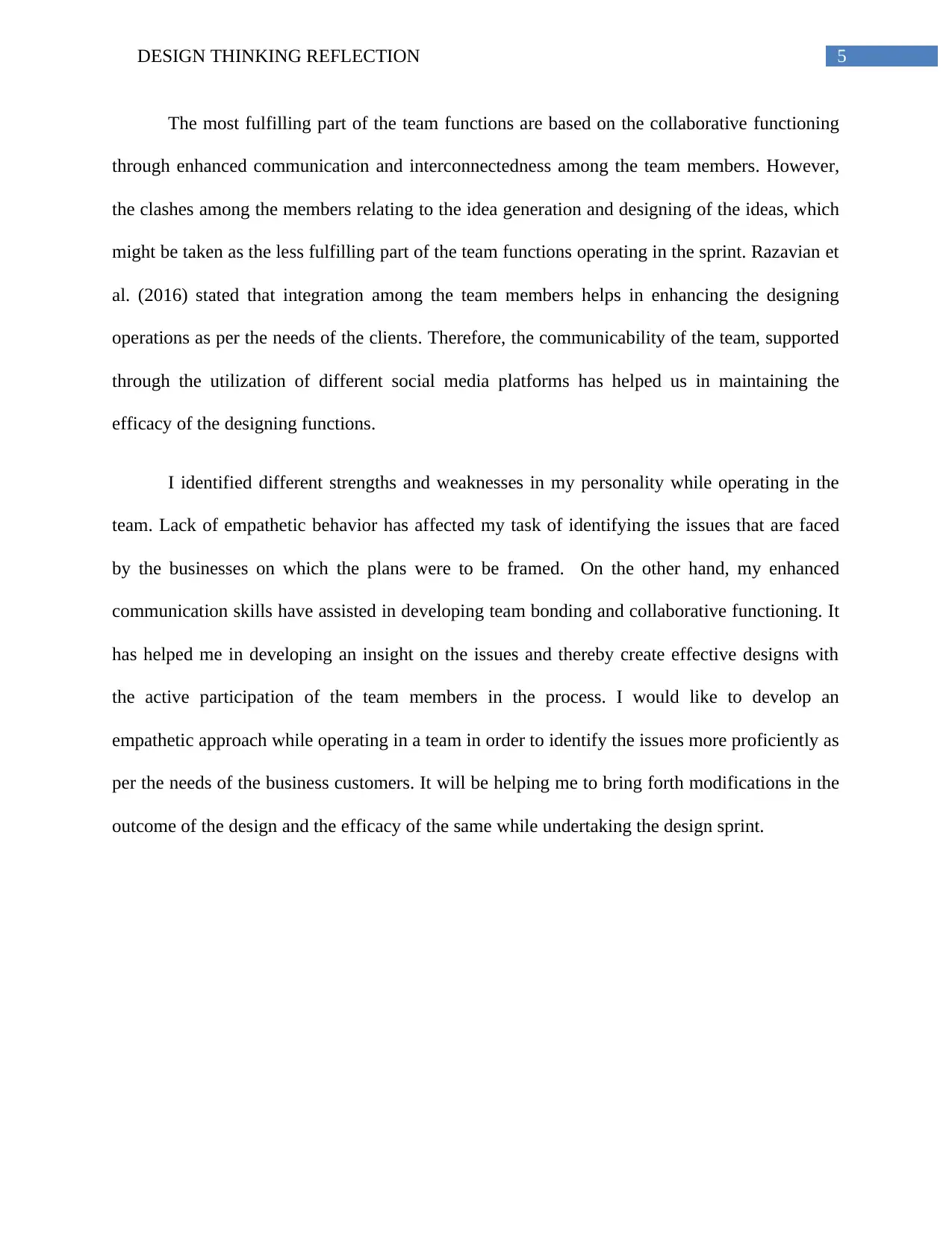
5DESIGN THINKING REFLECTION
The most fulfilling part of the team functions are based on the collaborative functioning
through enhanced communication and interconnectedness among the team members. However,
the clashes among the members relating to the idea generation and designing of the ideas, which
might be taken as the less fulfilling part of the team functions operating in the sprint. Razavian et
al. (2016) stated that integration among the team members helps in enhancing the designing
operations as per the needs of the clients. Therefore, the communicability of the team, supported
through the utilization of different social media platforms has helped us in maintaining the
efficacy of the designing functions.
I identified different strengths and weaknesses in my personality while operating in the
team. Lack of empathetic behavior has affected my task of identifying the issues that are faced
by the businesses on which the plans were to be framed. On the other hand, my enhanced
communication skills have assisted in developing team bonding and collaborative functioning. It
has helped me in developing an insight on the issues and thereby create effective designs with
the active participation of the team members in the process. I would like to develop an
empathetic approach while operating in a team in order to identify the issues more proficiently as
per the needs of the business customers. It will be helping me to bring forth modifications in the
outcome of the design and the efficacy of the same while undertaking the design sprint.
The most fulfilling part of the team functions are based on the collaborative functioning
through enhanced communication and interconnectedness among the team members. However,
the clashes among the members relating to the idea generation and designing of the ideas, which
might be taken as the less fulfilling part of the team functions operating in the sprint. Razavian et
al. (2016) stated that integration among the team members helps in enhancing the designing
operations as per the needs of the clients. Therefore, the communicability of the team, supported
through the utilization of different social media platforms has helped us in maintaining the
efficacy of the designing functions.
I identified different strengths and weaknesses in my personality while operating in the
team. Lack of empathetic behavior has affected my task of identifying the issues that are faced
by the businesses on which the plans were to be framed. On the other hand, my enhanced
communication skills have assisted in developing team bonding and collaborative functioning. It
has helped me in developing an insight on the issues and thereby create effective designs with
the active participation of the team members in the process. I would like to develop an
empathetic approach while operating in a team in order to identify the issues more proficiently as
per the needs of the business customers. It will be helping me to bring forth modifications in the
outcome of the design and the efficacy of the same while undertaking the design sprint.
⊘ This is a preview!⊘
Do you want full access?
Subscribe today to unlock all pages.

Trusted by 1+ million students worldwide
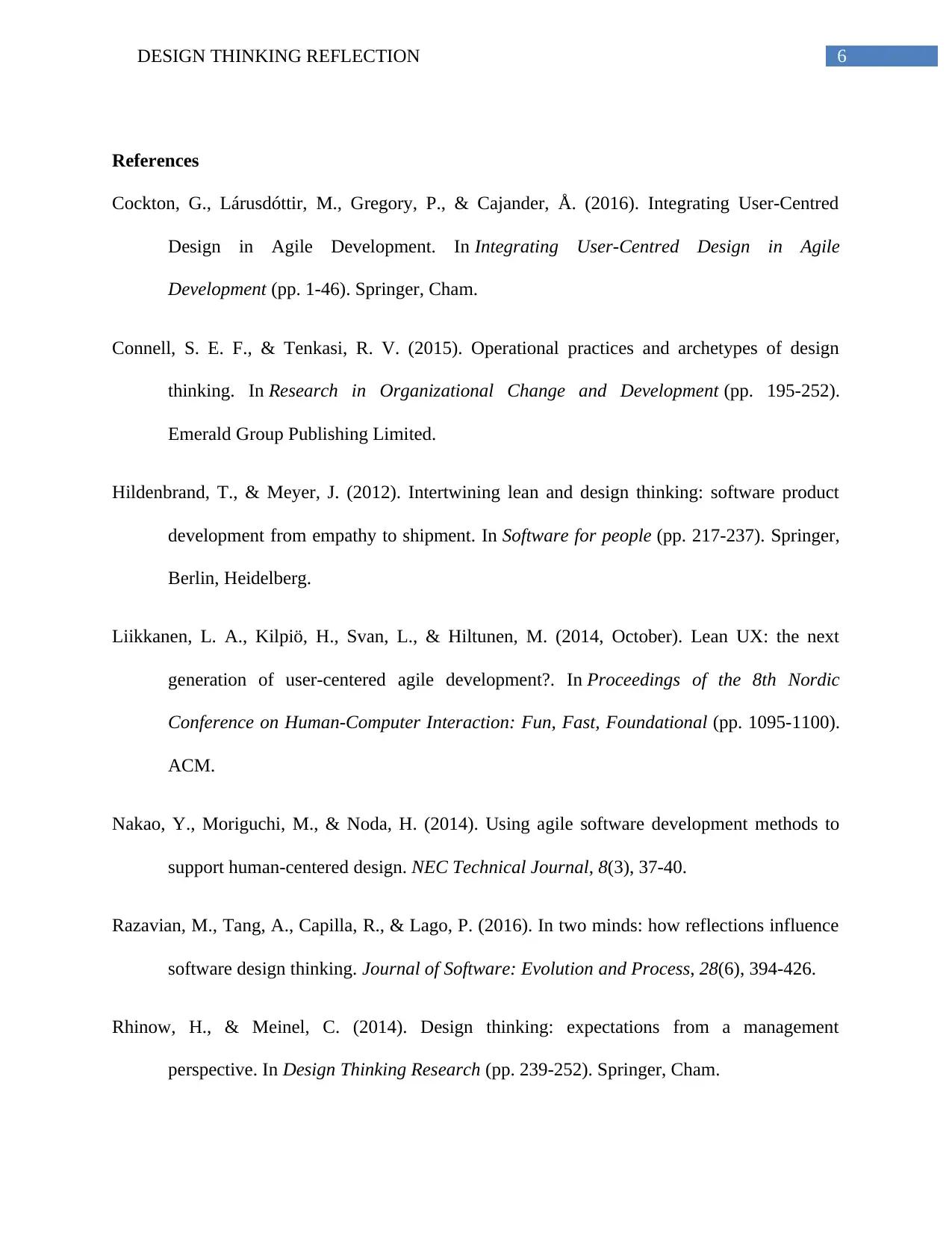
6DESIGN THINKING REFLECTION
References
Cockton, G., Lárusdóttir, M., Gregory, P., & Cajander, Å. (2016). Integrating User-Centred
Design in Agile Development. In Integrating User-Centred Design in Agile
Development (pp. 1-46). Springer, Cham.
Connell, S. E. F., & Tenkasi, R. V. (2015). Operational practices and archetypes of design
thinking. In Research in Organizational Change and Development (pp. 195-252).
Emerald Group Publishing Limited.
Hildenbrand, T., & Meyer, J. (2012). Intertwining lean and design thinking: software product
development from empathy to shipment. In Software for people (pp. 217-237). Springer,
Berlin, Heidelberg.
Liikkanen, L. A., Kilpiö, H., Svan, L., & Hiltunen, M. (2014, October). Lean UX: the next
generation of user-centered agile development?. In Proceedings of the 8th Nordic
Conference on Human-Computer Interaction: Fun, Fast, Foundational (pp. 1095-1100).
ACM.
Nakao, Y., Moriguchi, M., & Noda, H. (2014). Using agile software development methods to
support human-centered design. NEC Technical Journal, 8(3), 37-40.
Razavian, M., Tang, A., Capilla, R., & Lago, P. (2016). In two minds: how reflections influence
software design thinking. Journal of Software: Evolution and Process, 28(6), 394-426.
Rhinow, H., & Meinel, C. (2014). Design thinking: expectations from a management
perspective. In Design Thinking Research (pp. 239-252). Springer, Cham.
References
Cockton, G., Lárusdóttir, M., Gregory, P., & Cajander, Å. (2016). Integrating User-Centred
Design in Agile Development. In Integrating User-Centred Design in Agile
Development (pp. 1-46). Springer, Cham.
Connell, S. E. F., & Tenkasi, R. V. (2015). Operational practices and archetypes of design
thinking. In Research in Organizational Change and Development (pp. 195-252).
Emerald Group Publishing Limited.
Hildenbrand, T., & Meyer, J. (2012). Intertwining lean and design thinking: software product
development from empathy to shipment. In Software for people (pp. 217-237). Springer,
Berlin, Heidelberg.
Liikkanen, L. A., Kilpiö, H., Svan, L., & Hiltunen, M. (2014, October). Lean UX: the next
generation of user-centered agile development?. In Proceedings of the 8th Nordic
Conference on Human-Computer Interaction: Fun, Fast, Foundational (pp. 1095-1100).
ACM.
Nakao, Y., Moriguchi, M., & Noda, H. (2014). Using agile software development methods to
support human-centered design. NEC Technical Journal, 8(3), 37-40.
Razavian, M., Tang, A., Capilla, R., & Lago, P. (2016). In two minds: how reflections influence
software design thinking. Journal of Software: Evolution and Process, 28(6), 394-426.
Rhinow, H., & Meinel, C. (2014). Design thinking: expectations from a management
perspective. In Design Thinking Research (pp. 239-252). Springer, Cham.
Paraphrase This Document
Need a fresh take? Get an instant paraphrase of this document with our AI Paraphraser

7DESIGN THINKING REFLECTION
Sangiorgi, D., & Prendiville, A. (2014). A theoretical framework for studying service design
practices: First steps to a mature field. Design Management Journal, 9(1), 61-73.
Sangiorgi, D., & Prendiville, A. (2014). A theoretical framework for studying service design
practices: First steps to a mature field. Design Management Journal, 9(1), 61-73.
1 out of 8
Related Documents
Your All-in-One AI-Powered Toolkit for Academic Success.
+13062052269
info@desklib.com
Available 24*7 on WhatsApp / Email
![[object Object]](/_next/static/media/star-bottom.7253800d.svg)
Unlock your academic potential
Copyright © 2020–2025 A2Z Services. All Rights Reserved. Developed and managed by ZUCOL.





